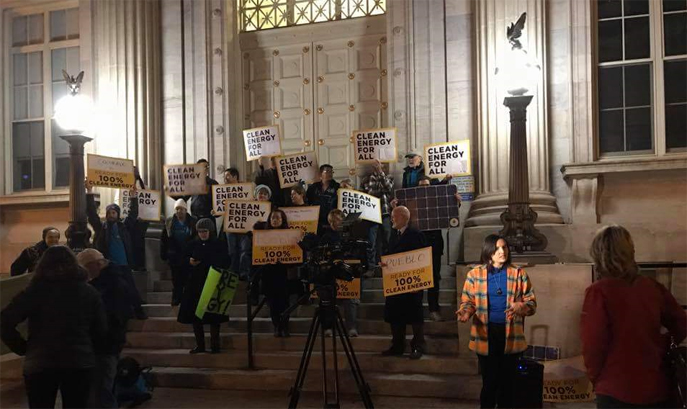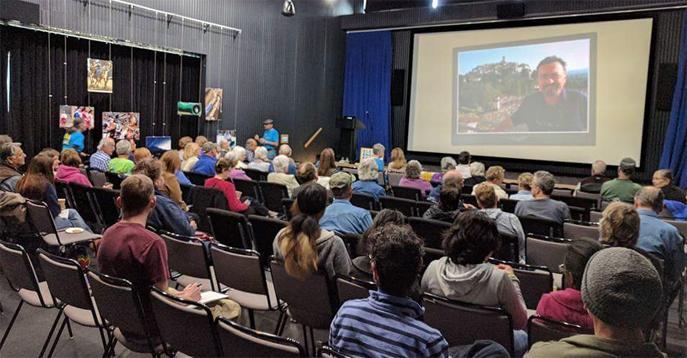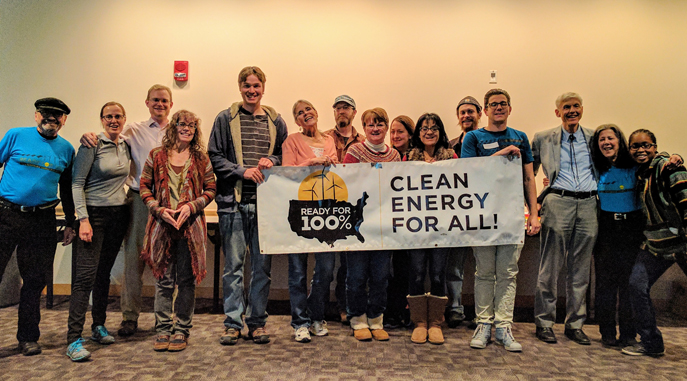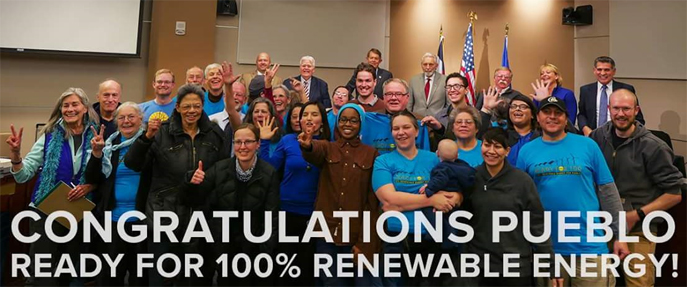Thanks largely to the efforts of local Sierra Club volunteers, city officials in Pueblo, Colorado, have set a goal of getting 100 percent of the city’s energy from renewable sources by 2035.
Pueblo was one of the first cities in the country to sign onto the Club’s Ready for 100 campaign to commit to 100 percent clean energy. “At the time, a lot of people wondered ‘Why Pueblo?’” says Ready for 100 director Jodie Van Horn.
But local Sierra Club leader David Cockrell and other activists with the Club’s Colorado Chapter and Sangre de Cristo Group knew exactly why it was important to fight for clean energy in Pueblo: it’s not only better for public health and the health of the planet, it’s more affordable. And along with local ally Pueblo’s Energy Future, they made a compelling case to local residents and the City Council, which in mid-February passed a resolution by a vote of 6-1, committing the city to running entirely on renewable energy by 2035.
Below, a clean energy rally at Pueblo's city hall, organized by the Sierra Club and Pueblo's Energy Future.

“This was a fight for energy justice by the people of Pueblo,” says Cockrell. “We’re a city of 110,000 people, 52 percent Hispanic, with a median annual household income of $34,000, as opposed to $58,000 for the state. Pueblo is far and away the poorest large community in Colorado.”
So why did launching a Ready for 100 campaign in Pueblo make such good sense?
In short, because an investor-owned, out-of-state utility was engaging in predatory business practices that were gouging and often literally turning out the lights on Puebloans.
Black Hills Energy, based in South Dakota, has been disconnecting about 7,000 utility accounts each year—out of a total of around 94,000 total accounts in Pueblo—for failure to pay.
“Many structures in this old steel-mill town are poorly insulated and energy-inefficient, and utility bills of $200 a month aren’t uncommon,” Cockrell explains. “A lot of residents can’t afford this so they get disconnected, then they live without heat because they can’t come up with the hefty reconnection fee plus a 3-month deposit, and they end up in the homeless shelter. We have a homeless population that has been generated by the electrical shutoffs generated by Black Hills Energy’s policies.”
Anne Stattelman is the director of Posada, an organization that provides housing to homeless families in Pueblo County. “When people lose their electricity, they lose their houses,” she says. “Pueblo is one of Colorado’s poorest cities but has one of the highest electricity rates in the state.
“It’s often taken for granted, but nearly every facet of modern life depends on electricity. When the power goes off, refrigerators full of food go to waste. Children can’t take hot showers or do their homework. Parents have to choose between dinner, medicine, or keeping the lights on.”
In 2008, Black Hills Energy acquired the region’s previous utility company and received authorization for a new $72 million gas-fired power plant. The company raised their rates to cover the costs and installed “smart meters” in low-income neighborhoods—a move that makes it easier to shot off power remotely. In 2015, Black Hills disconnected more than 6,000 households in Pueblo, a city of roughly 43,000 households.
“Most people who live here have been here awhile, and they see how the rate hike has affected them,” says Rebecca Vigil, a Pueblo native, business owner, and community organizer with Pueblo’s Energy Future (PEF). “I’ve seen how this has affected my city, and for the past six to eight years, there’s been a definite blight. We live in one of the most socio-economically disadvantaged municipalities in the state,” yet we pay one of the highest electric rates in the nation.”
But changes are afoot for the Steel City’s energy future. (Sorry, Pittsburgh, Pa., you’re not the only city to lay claim to this nickname.) Over the last year-and-a-half, the Sierra Club and PEF have spearheaded a grassroots campaign to replace Black Hills Energy’s gas-burning plant with clean, renewable energy.
The Sierra Club’s Ready for 100 campaign in Pueblo included energy experts and elected officials but was mostly made up of just plain concerned residents. “Our coalition came together around the tripartite missions of energy justice, business competitiveness, and clean energy,” Cockrell explains. “We believe these three things are not only compatible; they’re inseparable.”
Funded by the Ready for 100 campaign, the coalition held three work sessions with the city council to show them the level of profiteering Black Hills Energy was getting away with in Pueblo.

“Black Hills stockholders earn 9.3% on their investment on the backs of Pueblo ratepayers, and all of that money goes out of state,” Cockrell says. “This really resonated with the council. We made the case that the best way to stabilize our rates and simultaneously stabilize our community is for Black Hills to transition off gas and onto renewables.”
Utility-scale renewables are now cheaper than natural gas. The cost of building of a new wind plant is less than the cost of running the natural gas plant, It would be cheaper for Black Hills to build new wind farms than to run their existing natural gas plants. Ironically, Black Hills fully understands this, and they’ve now proposed to build three major new wind farms and produce 65 percent of their energy from wind by 2038.
“But why stop at 65 percent?” Cockrell asks. “We told the city council, ‘Let’s shoot for 100 percent.’ And the council ultimately saw the wisdom in doing just that.
Another ally who was key to the coalition’s success was Daneya Esgar, Pueblo’s state rep in the Colorado House and a member of Pueblo’s Energy Future, who hosted three town halls at which Sierra Club and PEF activists were able to explain the economic benefits of transitioning away from fossil fuels and onto clean energy.
“That’s what ultimately really hit home with the community,” Cockrell says. “It goes without saying that the Sierra Club believes climate change is the most urgent and significant challenge we face today. But the economic argument behind transitioning to clean energy was our way to get the community behind this.”
We’ll let the last word go to Rebecca Vigil: “With renewable energy, we will be able to stabilize the price of electricity while bringing job growth to the community and picking up where the Sierra Club’s Ready for 100 campaign left off. This campaign gave voice to the concerns of the marginalized, and that is empowering. I truly believe that we the community—we the people—can be a catalyst for change.”

